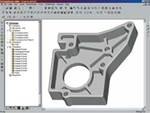Rethinking STEP-NC
This standardized machine tool control language enables CNC machining to be part of a larger, collaborative process.
The initial reports about STEP-NC focused on the fact that this standardized machine tool control language replaced G-code part programming, thereby eliminating some of the limitations of this traditional method for running CNC machines. Certainly that was the tack that I took to covering this development when it emerged about 10 years ago. Because it is a radical departure from the usual approach to programming, it was hard to get our heads around the concept of STEP-NC at the time. The striking contrast to G-code programming was the best entry point to open this discussion.
Traditionally, part geometry is fed into CAM software to generate a file of G-code tool paths subsequently postprocessed for a particular machine tool and CNC. STEP-NC involves creating a “part model” that incorporates all of the information needed to produce the workpiece anywhere, anytime, on any machine (suitably configured to do the work, of course). A STEP-NC program is designed to provide a complete description of what is to be machined, not how to move the axes to machine it. Information about the raw stock, the geometric features to be machined, the order of the appropriate machining steps, the tolerances to be met and the cutting tools needed to meet these requirements are all intended as content in a STEP-NC file. Axis motion commands (the equivalent of G codes) are not generated until the CNC processes the part model data with installed CAM software during program execution.
For a while, this concept seemed poised to transform the world of CNC machining, but the promised transformation didn’t happen. STEP-NC seemed to recede into the background as the elaborate standards-making process ground on. Meanwhile, CAM software developers continued to focus on better toolpath strategies and more powerful user interfaces. Postprocessors became more reliable and readily available. So conventional G-code programming held on as the prevalent format for machine tool input.
Unfortunately, the underlying limitations of this programming method didn’t go away. The lack of program exchangeability on the shop floor remained a vexing hindrance. Over time, G-code programs often became useless as CAM systems changed or disappeared, the original machine was replaced, or the specified cutting tools were replaced by much more capable products.
STEP-NC didn’t go away either. A number of parties have continued to develop this standard. It is re-emerging as a universal CAM translator that enables designers and engineers to talk in a language about a part model that machine tools can also understand.
Now it’s time to reassess the value of STEP-NC as a tool for collaboration. The rise of the thoroughly networked environment of data-driven manufacturing and digital integration across the entire supply chain demands collaboration at every level. No tool for collaboration can be overlooked. Perhaps STEP-NC wasn’t ready to change the world 10 years ago. Perhaps today, a changing world is ready for STEP-NC.
Related Content
-
Finally, A Comprehensive Software Solution Designed for Small Job Shops
Zel X from Siemens is an integrated software application that consolidates collaboration, design, manufacturing, and operations into a comprehensive, easy-to-use solution. From RFQ to delivery, it’s a more efficient way to handle quotes, manage jobs, make parts, and collaborate with teams of all sizes.
-
Give Job Shop Digitalization a Customer Focus
Implementing the integrated digital technologies and automation that enhance the customer's experience should be a priority for job shops and contract manufacturers.
-
How this Job Shop Grew Capacity Without Expanding Footprint
This shop relies on digital solutions to grow their manufacturing business. With this approach, W.A. Pfeiffer has achieved seamless end-to-end connectivity, shorter lead times and increased throughput.













